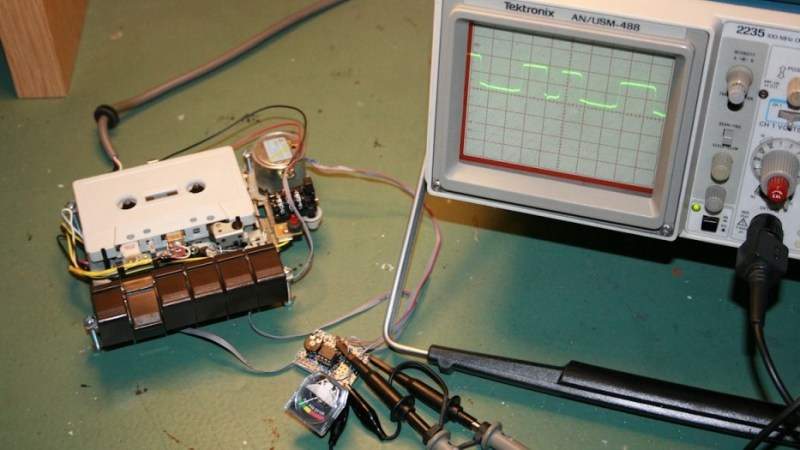For present-day owners of vintage Commodore computers, keeping data and programs safe and backed up is top priority. Disk drive storage was more common in the US, whereas in Europe, the audio cassette was the preferred medium of storage.
The Datasette device was what allowed interfacing the cassettes to the computer. Tape head alignment was critical to successfully writing and reading data to the cassette. Some models of the Datasette came with a small hole above the keys, to allow access to the adjustment screw of the tape head azimuth position. Tweaking this while looking at a signal meter could help you improve the signal from a bad cassette and prevent load errors. [Jani] tried a commercial solution called “Load-IT” which had a LED bargraph, but it couldn’t help much dealing with tapes with very bad signals. So he built a signal strength meter for his Datasette. He calls it the VU-sette since it uses an analog style meter quite similar to the VU-meters found in many audio equipment.
The hardware is simple and uses commonly available parts. The analog meter is extracted from a Battery Checker sourced from eBay. An op-amp drives the analog meter, and another transistor drives a separate speaker. This can be used to listen in on the cassette, if the speaker is enabled via a push button. [Jani] first breadboarded and tested the circuit before ordering out prototype boards.
To test performance, [Jani] used FinalTAP, a tool for examining, cleaning and restoring digitized data cassette tapes (TAP files) for the Commodore 64 computer. The “LOAD-IT” version worked well with tapes that were in fairly good condition. But his VU-sette version allowed him to adjust the head more precisely and get out a much better read from bad tapes. While on the subject, check out this nice 7-segment bubble LED digital counter for the 1530.
















I had a computer with an integrated cassette drive that no one’s ever heard of–an Interact Model one. It frequently went out of alignment and there was an alignment program tape available for it so I learned how to adjust the read head. Later I got a Vic 20 which was actually a step up from the Interact. When it started having load problems I knew just what was wrong. The datasette I had DIDN’T have a hole to access the alignment screw so I drilled my own. I also didn’t have an alignment tape, but turning the head a quarter turn one way or the other generally did the job.
Oric Atmos was a pain with alignment ! ;-)
I had a VU meter on my C64 datasette in 1984. Using a 741 opamp and some huge VU meter that I salvaged from I-have-no-clue-what. :) Worked perfectly, never had loading errors after that. I got the schematics from some German magazine. But the thing is: I remember it was connected to the output, not somewhere internal in the chain of amplifiers.
on the trs-80, I was cassette bound for years before I could afford a 5.25″ floppy. the solution to this problem was to use a 566 PLL chip that would lock-on to the freq regardless of the amplitude and then trigger a 555 to create new fresh tones. it was common for the trs80 and it allowed a LOT more leeway in setting playback volume this way.
I cannot afford a data cassette, so I just made an adapter to use a regular cassette player.
FinalTAP is great software. I used it to clean up some dumps of old C64 games made using a conventional (badly aligned) tape player, including this long-lost RPG for the VIC-20 “Dungeons of Death”.
http://sleepingelephant.com/ipw-web/bulletin/bb/viewtopic.php?p=61567#p61567
A bit out of topic but I like Android app TAP Dancer that play the sound TAP/T64/PRG/P00 / TZX / CDT / UEF / CAS to Audio (WAV) of C64/128/VIC20 / SINCLAIR/AMSTRAD ACORN/BBC / MSX / ATARI
Then this file’s sound can be played into computer tape-in audio.
https://play.google.com/store/apps/details?id=co.kica.tapdancer
Thanks!
Funny. I just bought one on eBay last night for my C64. I’ve been wondering how to adjust the heads, now I know.